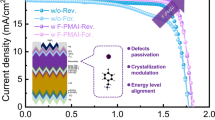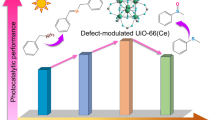Abstract
Defect engineering greatly enhances the catalytic activity of transition metal semiconductor photocatalysts. Recently, localized surface defects engineering has been intensively researched, but it still remains challenges on how to tilt the balance to the controllable construction of surface defects rather than bulk ones. Here, we report a facile room-temperature solution processing strategy on (001) facet exposed anatase TiO2 nanosheets (ATO), in which localized defects are generated on the surface selectivity with high concentration. To achieve the aspect, lithium-ethylenediamine (Li-EDA) treatment is carried out on (001) facet exposed ATO under a mild condition. The optimized sample exhibits outstanding photocatalytic H2 production rates of 9.28 mmol·g−1·h−1 with loading 0.5 wt% Pt as co-catalyst (AM 1.5), which is nearly 7.5 times higher than that of the pristine ATO. This defect engineering strategy of ATO photocatalyst will spark the ideas for the defects engineering and semiconductor photocatalyst, which is with important application prospect in solar energy conversion, including hydrogen generation and carbon dioxide reduction.
Graphical abstract

摘要
缺陷工程极大地提高了过渡金属半导体光催化剂的催化活性, 如何进行表面缺陷的可控构筑而非体相缺陷, 仍然是一个挑战。这里, 我们报告了一种基于锂-乙二胺 (Li-EDA) 的简便室温液相处理策略, 该策略在温和条件下选择性地在 (001) 面暴露的锐钛矿二氧化钛纳米片 (ATO) 上构建表面 Ti3+ 缺陷。结果表明, 表面Ti3+ 缺陷不仅提高了电荷分离效率, 而且为H2的析出提供了活性位点。结果表明, 在A.M. 1.5G条件下, 具有表面 Ti3+ 缺陷的 ATO 负载 0.5 wt% 的铂作为助催化剂时, 表现出出色的光催化产氢效率, 可达 9.28 mmol g−1·h−1, 比原始ATO高近7.5倍。此外, 与通过硼氢化钠热还原处理合成的同时具有体相和表面缺陷的 ATO 相比, 仅有表面 Ti3+ 缺陷的 ATO, 其光催化产氢效率也增加了近 2.9倍。






Similar content being viewed by others
References
Chen XB, Shen SH, Guo LJ, Mao SS. Semiconductor-based photocatalytic hydrogen generation. Chem Rev. 2010;110(11):6503.
Wang ZM, Shen ZY, Li YM, Zuo JL. Preparation and photoelectrocatalytic performance of Ru loaded TiO2 nanotubes. Chin J Rare Metals. 2020;44(6):609.
Zhao CX, Ding C, Han CH, Yang XF, Xu JS. Lignin-incorporated supramolecular copolymerization yielding g-C3N4 nanoarchitectures for efficient photocatalytic hydrogen evolution. Solar RRL. 2020;5(2):2000486.
Li X, Wan T, Qiu JY, Wei H, Qin FH, Wang YH, Liao YJ, Huang ZY, Tan XC. In-situ photocalorimetry-fluorescence spectroscopy studies of RhB photocatalysis over Z-scheme gC3N4@Ag@Ag3PO4 nanocomposites: a pseudo-zero-order rather than a first-order process. Appl Catal B. 2017;217(15):591.
Wang LY, Liu JL, Min YL, Zhang K. Nontopological transformation of hierarchical TiO2 by self-regulated etching and capping roles of F- for photocatalytic H2 evolution. Appl Surf Sci. 2019;473(15):738.
Wang LY, Lu Y, Han NN, Dong CR, Lin C, Lu SY, Min YL, Zhang K. Suppressing water dissociation via control of intrinsic oxygen defects for awakening solar H2O-to-H2O2 generation. Small. 2021;17(13):2100400.
Ha EN, Lee LYS, Wang JC, Li FH, Wong KY, Tsang SCE. Significant enhancement in photocatalytic reduction of water to hydrogen by Au/Cu2ZnSnS4 nanostructure. Adv Mater. 2014;26(21):3496.
Sun J, Zhang M, Wang ZF, Chen HY, Chen Y, Murakami N, Ohno T. Synthesis of anatase TiO2 with exposed 001 and 101 facets and photocatalytic activity. Rare Met. 2019;38(4):287.
Wang LY, Tsang CS, Liu W, Zhang XD, Zhang K, Ha EN, Kwok WM, Park JH. Disordered layers on WO3 nanoparticles enable photochemical generation of hydrogen from water. J Mater Chem A. 2019;7(1):221.
Zheng ZK, Huang BB, Lu JB, Wang ZY, Qin XY, Zhang XY, Dai Y, Whangbo MH. Hydrogenated titania: synergy of surface modification and morphology improvement for enhanced photocatalytic activity. Chem Commun. 2012;48(46):5377.
Qiu JY, Chen JH, Xiao BY, Li XX, Huang ZY. Oxygen deficient TiO2-x with dual reaction sites for activation of H2O2 to degrade organic pollutants. Catal Lett. 2020;150(6):222.
Qin FH, Wan T, Qiu JY, Wang YH, Xiao BY, Huang ZY. Temperature effects on photocatalytic heat changes and kinetics via in situ photocalorimetry fluorescence spectroscopy. Acta Phys Chim Sin. 2020;36(6):1905087.
Li LD, Yan JQ, Wang T, Zhao ZJ, Zhang J, Gong JL, Guan NG. Sub-10nm rutile titanium dioxide nanoparticles for efficient visible-light-driven photocatalytic hydrogen production. Nat Commun. 2015;6:5881.
Chen XB, Liu L, Liu Z, Marcus MA, Wang WC, Oyler NA, Grass ME, Mao BH, Glans PA, Yu PY, Guo JH, Mao SS. Properties of disorder-engineered black titanium dioxide nanoparticles through hydrogenation. Sci Rep. 2013;3:1510.
Zhu YY, Qiang L, Liu YF, Wang H, Zhu YF. Photocatalytic performance of BiPO4 nanorods adjusted via defects. Appl Catal B. 2016;187(15):204.
Chen XB, Liu L, Yu PY, Mao SS. Increasing solar absorption for photocatalysis with black hydrogenated titanium dioxide nanocrystals. Science. 2011;331:746.
Zhang YC, Afzal N, Pan L, Zhang XW, Zou JJ. Structure-activity relationship of defective metal-based photocatalysts for water splitting: experimental and theoretical perspectives. Adv Sci. 2019;6(10):1900053.
Zhang YC, Li Z, Zhang L, Pan L, Zhang XW, Wang L, Aleem FE, Zou JJ. Role of oxygen vacancies in photocatalytic water oxidation on ceria oxide: experiment and DFT studies. Appl Catal B. 2018;224:101.
Fang WZ, Xing MY, Zhang JL. A new approach to prepare Ti3+ self-doped TiO2 via NaBH4 reduction and hydrochloric acid treatment. Appl Catal B. 2014;160:240.
Ariyanti D, Mills L, Dong JZ, Yao Y, Gao W. NaBH4 modified TiO2: defect site enhancement related to its photocatalytic activity. Mater Chem Phys. 2017;199(15):571.
Ohajernia S, Andryskova P, Zoppellaro G, Hejazi S, Kment S, Zboril R, Schmidt J, Schmuki P. Influence of Ti3+ defect-type on heterogeneous photocatalytic H2 evolution activity of TiO2. J Mater Chem A. 2020; 8(3):1432.
Fujishima A, Honda K. Electrochemical photolysis of water at a semiconductor electrode. Nature. 1972;238:37.
Li CC, Wang T, Zhao ZJ, Yang WM, Li JF, Li A, Yang ZL, Ozin GA, Gong JL. Promoted fixation of molecular nitrogen with surface oxygen vacancies on plasmon-enhanced TiO2 photoelectrodes. Angew Chem Int Ed. 2018;57(19):5278.
Yu XM, Kim B, Kim YK. Highly enhanced photoactivity of anatase TiO2 nanocrystals by controlled hydrogenation-induced surface defects. ACS Catal. 2013;3(11):2479.
Zhang W, He H, Tian Y, Lan K, Zu LH, Xia Y, Duan LL, Li W, Zhao DY. Defect-engineering of mesoporous TiO2 microspheres with phase junctions for efficient visible-light driven fuel production. Nano Energy. 2019;66:104113.
Li H, Guo Y, Robertson J. Calculation of TiO2 surface and subsurface oxygen vacancy by the screened exchange functional. J Phys Chem C. 2015;119(32):18160.
Zhang K, Wang LY, Kim JK, Ma M, Veerappan G, Lee CL, Kong KJ, Lee HL, Park JH. An order/disorder/water junction system for highly efficient co-catalyst-free photocatalytic hydrogen generation. Energy Environ Sci. 2016;9(2):499.
Liu G, Yang HG, Pan J, Yang YQ, Lu GQ, Chen HM. Titanium dioxide crystals with tailored facets. Chem Rev. 2014;114(19):9559.
Vittadini A, Selloni A, Rotzinger FP, Gratzel M. Structure and energetics of water adsorbed at TiO2 anatase (101) and (001) surfaces. Phys Rev Lett. 1998;81(14):2954.
Han XG, Kuang Q, Jin MS, Xie ZX, Zheng LS. Synthesis of titania nanosheets with a high percentage of exposed (001) facets and related photocatalytic properties. J Am Chem Soc. 2009;131(9):3152.
Yu JG, Low JX, Xiao W, Zhou P, Jaroniec M. Enhanced photocatalytic CO2-reduction activity of anatase TiO2 by coexposed 001 and 101 facets. J Am Chem Soc. 2014;136(25):8839.
Hu Z, Li K, Wu XN, Wu XF, Wang N, Li XF, Li Q, Li L, Lv KL. Dramatic promotion of visible-light photoreactivity of TiO2 hollow microspheres towards NO oxidation by introduction of oxygen vacancy. Appl Catal B. 2019;256:117860.
Zhang H, Cai JM, Wang YT, Wu MQ, Meng M, Tian Y, Li XG, Zhang J, Zheng LR, Jiang Z, Gong JJ. Insights into the effects of surface/bulk defects on photocatalytic hydrogen evolution over TiO2 with exposed 001 facets. Appl Catal B. 2018;220:126.
Tian F, Zhang YP, Zhang J, Pan CX. Raman spectroscopy: a new approach to measure the percentage of anatase TiO2 exposed (001) facets. J Phys Chem C. 2012;116(13):7515.
Liu XG, Dong GJ, Li SP, Lu GX, Bi YP. Direct observation of charge separation on anatase TiO2 crystals with selectively etched 001 facets. J Am Chem Soc. 2016;138(9):2917.
Liu G, Yang HG, Wang XW, Cheng LN, Lu HF, Wang LZ, Gao Q, Chen HM. Enhanced photoactivity of oxygen-deficient anatase TiO2 sheets with dominant 001 facets. J Phys Chem C. 2009;113(52):21784.
Nakamura I, Negishi N, Kutsuna S, Ihara T, Sugihara S, Takeuchi K. Role of oxygen vacancy in the plasma-treated TiO2 photocatalyst with visible light activity for NO removal. J Mol Catal A: Chem. 2000;161:205.
Strunk J, Vining WC, Bell AT. A study of oxygen vacancy formation and annihilation in submonolayer coverages of TiO2 dispersed on MCM-48. J Phys Chem C. 2010;114(40):16937.
Kong M, Li Y, Chen X, Tian TT, Fang PF, Zheng F, Zhao XJ. Tuning the relative concentration ratio of bulk defects to surface defects in TiO2 nanocrystals leads to high photocatalytic efficiency. J Am Chem Soc. 2011;133(41):16414.
Li A, Chang XX, Huang ZQ, Li CC, Wei YJ, Zhang L, Wang T, Gong JL. Thin heterojunctions and spatially separated cocatalysts to simultaneously reduce bulk and surface recombination in photocatalysts. Angew Chem Int Ed. 2016;128(44):13938.
Zhao K, Zhang ZS, Feng YL, Lin SL, Li H, Gao X. Surface oxygen vacancy modified Bi2MoO6/MIL-88B (Fe) heterostructure with enhanced spatial charge separation at the bulk & interface. Appl Catal B. 2020;268:118740.
Duzhko V, Timoshenko VY, Koch F, Dittrich T. Photovoltage in nanocrystalline porous TiO2. Phys Rev B. 2001;64(7):075204.
Cheng M, Yang L, Li HY, Bai W, Xiao C, Xie Y. Constructing charge transfer channel between dopants and oxygen vacancies for enhanced visible-light-driven water oxidation. Nano Res. 2021;323:1.
Liao L, Jin K, Ge C, Hu CL, Hu HB, Yang GZ. A theoretical study on the dynamic process of the lateral photovoltage in perovskite oxide heterostructures. Appl Phys Lett. 2010;96(6):062116.
Ha EN, Ruan SH, Li DY, Zhu YM, Chen YP, Qiu JY, Chen CH, Xu TT, Su JY, Wang LY, Hu JQ. Surface disorder engineering in ZnCdS for cocatalyst free visible light driven hydrogen production. Nano Res. 2021. https://doi.org/10.1007/s12274-021-3587-5.
Li S, Meng DD, Hou LB, Wang DJ, Xie TF. The surface engineering of CdS nanocrystal for photocatalytic reaction: a strategy of modulating the trapping states and radicals generation towards RhB degradation. Appl Surf Sci. 2016;371:164.
Li S, Hou LB, Zhang L, Chen LP, Lin YH, Wang DJ, Xie TF. Direct evidence of the efficient hole collection process of the CoOx cocatalyst for photocatalytic reactions: a surface photovoltage study. J Mater Chem A. 2015;3(34):17820.
Jiang TF, Xie TF, Chen LP, Fu ZW, Wang DJ. Carrier concentration-dependent electron transfer in Cu2O/ZnO nanorod arrays and their photocatalytic performance. Nanoscale. 2013;5(7):2938.
Zhang T, Wu MY, Yan DY, Mao J, Liu H, Hu WB, Du XW, Lin T, Qiao SZ. Engineering oxygen vacancy on NiO nanorod arrays for alkaline hydrogen evolution. Nano Energy. 2018;43:103.
Feng HF, Xu ZF, Ren L, Liu C, Zhuang JC, Hu ZP, Xu X, Chen J, Wang JO, Hao WC, Du Y, Dou SX. Activating titania for efficient electrocatalysis by vacancy engineering. ACS Catal. 2018;8(5):4288.
Acknowledgements
This study was financially supported by the National Natural Science Foundation of China (Nos. 21902104 and 21701135), the Natural Science Foundation of Top Talent of Shenzhen Technology University (No. 2019108101003) and the Foundation for Young Innovative Talents in Higher Education of Guangdong (No. 2018KQNCX401).
Author information
Authors and Affiliations
Corresponding author
Ethics declarations
Conflict of interests
The authors declare that they have no conflict of interest.
Supplementary Information
Below is the link to the electronic supplementary material.
Rights and permissions
About this article
Cite this article
Qiu, JY., Feng, HZ., Chen, ZH. et al. Selective introduction of surface defects in anatase TiO2 nanosheets for highly efficient photocatalytic hydrogen generation. Rare Met. 41, 2074–2083 (2022). https://doi.org/10.1007/s12598-021-01929-4
Received:
Revised:
Accepted:
Published:
Issue Date:
DOI: https://doi.org/10.1007/s12598-021-01929-4




